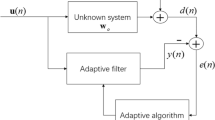Abstract
Classical adaptive beamforming strategies have been shown to exhibit a substantial performance degradation if an error exists in the estimation of the angle of arrival (AOA). The optimization problem can be modified to incorporate an improved constraint allowing for robustness to AOA imperfections. In this paper, we propose a gradient descent implementation of the robust adaptive beamformer whereby a direct relation is established between the Lagrange multiplier and the adaptation step size. This allows for the heuristic approximation of one of the parameters while establishing a valid range for the other. Computer simulations have been used to confirm the findings of this study and illustrate the performance of the developed algorithm.







Similar content being viewed by others
References
Frost, O.L.: An algorithm for linearly constrained algorithm adaptive array processing. Proc. IEEE 60(8), 926–935 (1972)
Litva, J., Lo, T.K.: Digital Beamforming in Wireless Communications. Artech House Pub., Boston (1996)
Foutz, J., Spanias, A., Banavar, M.K.: Narrowband Direction of Arrival Estimation for Antenna Arrays. Synthesis Lectures on Antennas. Morgan & Claypool Pub., San Rafael (2008)
Li, J., Stoica, P.: Robust Adaptive Beamforming. Wiley Series in Telecommunications and Signal Processing. Wiley, New York (2006)
Feldman, D., Griffiths, L.J.: A projection approach for robust adaptive beamforming. IEEE Trans. Signal Process. 42(4), 867–876 (1994)
Li, Y., Wan, Q., Fan, R.:’ A robust beamformer with virtual array. In: International Conference on Electronics, Communications and Control, pp. 2479–2482, 2011
Yu, Z.L., Gu, Z., Zhou, J., Li, Y., Ser, W., Er, M.H.: A robust adaptive beamformer based on worst-case semi-definite programming. IEEE Trans. Signal Process. 58(11), 5914–5919 (2010)
Zhang, T., Sun, L.: Iterative robust beamformer with an estimation of uncertainty level. In: Wireless Symposium, pp. 1–3. IEEE International (2013)
Shi, Y., Huang, L., Qian, C., Wang, Y., Xie, W., So, H. C.: A novel worst-case robust beamformer based on interference-plus-noise covariance reconstruction and uncertainty level estimation. In: ChinaSIP, pp. 746–750, 2015
Xin, D., Guisheng, L., Hongqing, L., Haihong, T.: Robust constrained LMS adaptive beamformer. In: International Conference on Radar, pp. 1–4, 2006
Yu, Z.L., Ser, W., Er, M.H.: A novel robust beamformer based on linear optimization. In: International Conference on Information, Communications and Signal Processing, pp. 1–4, 2007
Yu, Z.L., Ser, W., Er, M.H., Chen, H.: Robust adaptive beamformer exploiting symmetric structure of array. In: IEEE Conference on Industrial Electronics and Applications, pp. 2439–2443, 2008
Han, Yubing, Tran, Vanha: Recursive Bayesian beamforming with uncertain projected steering vector and strong interferences. SIViP 10, 975–982 (2016)
Liao, B., Guo, C., Huang, L., Li, Q., So, H.C.: A robust beamformer with main beam control. In: IEEE Sensor Array and Multichannel Signal Processing Workshop (SAM), pp. 1–5, 2016
Li, Q., Wang, W., Xu, D., Wang, X., Han, Z.: Robust beamformer based on magnitude response constraint and steering vector correction. Electron. Lett. 51(17), 1302–1304 (2015)
Vorobyov, S.A., Gershman, A.B., Luo, Z.: Robust adaptive beamforming using worst-case performance optimisation: a solution to the signal mismatch problem. IEEE Trans. Signal Process. 51(2), 313–324 (2003)
El-Keyi, A., Kirubarajan, T., Gershman, A.B.: Robust adaptive beamforming based on the Kalman filter. IEEE Trans. Signal Process. 53(8), 3032–3041 (2005)
Sturm, J.F.: Using SeDuMi 1.02, a Matlab toolbox for optimization over symmetric cones. Optim. Methods Softw. 11–12, 625–653 (1999)
Kim, J.W., Un, C.K.: An adaptive array robust to beam pointing error. IEEE Trans. Signal Process. 40(6), 1582–1584 (1992)
Gershman, A.B.: Robust adaptive beamforming in sensor arrays. Int. J. Electron. Commun. 53, 305–314 (1999)
Author information
Authors and Affiliations
Corresponding author
Rights and permissions
About this article
Cite this article
Korayem, R., Bendoukha, S. A gradient descent implementation of the adaptive robust narrowband constrained LMS beamformer. SIViP 12, 463–470 (2018). https://doi.org/10.1007/s11760-017-1180-x
Received:
Revised:
Accepted:
Published:
Issue Date:
DOI: https://doi.org/10.1007/s11760-017-1180-x




